Learn how to make homemade oat flour from oats in just a few minutes with tips and tricks to make sure it turns out perfectly every time! This guide will teach you which oats to use, how to blend, store, and even which recipes to use it in.
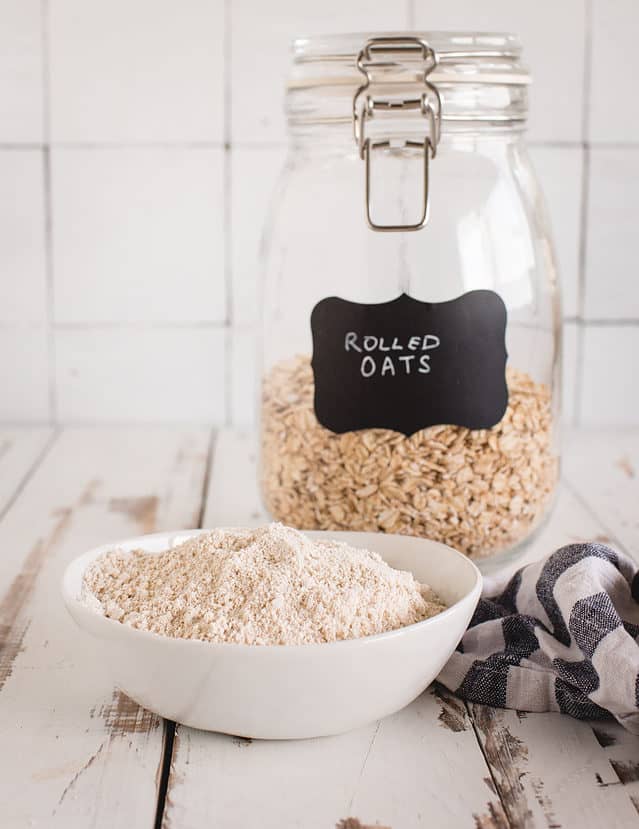
What is oat flour
Oat flour is ground up oats that are blended into a fine flour consistency. It can easily be made in a high speed blender at home in just a few minutes! DIY oat flour is less expensive than buying it pre-ground in grocery stores and is simple to create the same quality as pre-packaged.
Whether you’re trying to eat healthier or regularly bake with gluten-free flours, oatmeal flour, as it is sometimes called, is an excellent pantry staple. It’s a great healthy option for consuming whole grains overall. Compared to white flour, it tastes nuttier and more like oats which adds a nice subtle flavor to baked goods.
Oat flour has more protein and fiber that regular flour and has beta glucan (not to be confused with gluten!) which creates a feeling of satiety to keep you full longer. While you cannot substitute 1:1 for all purpose flour, it is nutritious and an excellent option for baking.
It works great in my oat flour peanut butter muffin recipe – it get’s rave reviews! Making oat flour pancakes or waffles is another great way to eat oat flour in a delicious way, that certainly doesn’t taste like health foo
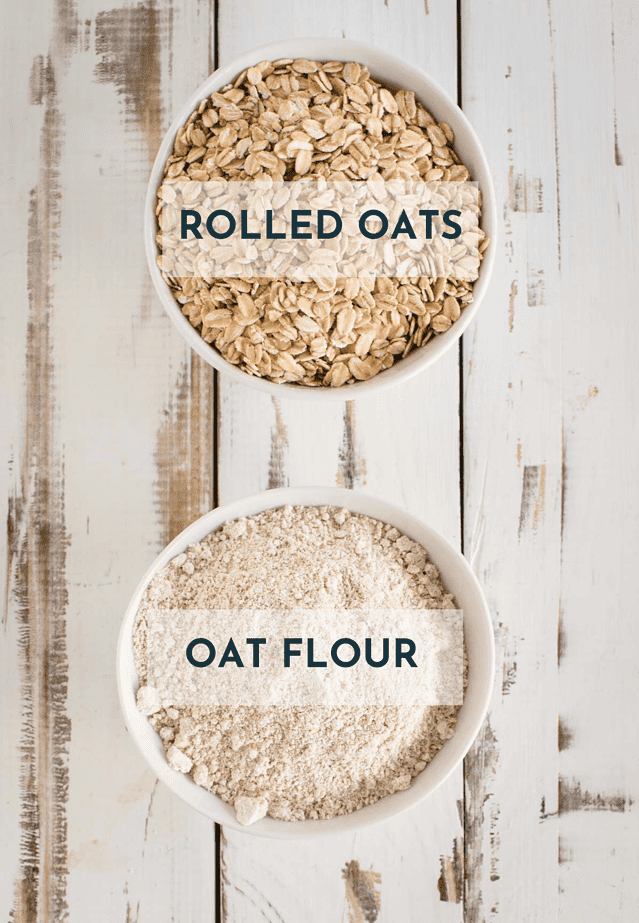
Which oats to use for homemade oat flour
While you can technically use various different forms of oats, rolled oats (old fashioned oats) are the best to use. You can also use steel cut or quick oats if you have those on hand and prefer to use them instead but rolled oats are the best way to do it.
Steel cut oats are not steamed and are more dense so the flour will be slightly darker and you will create more of it than you would with rolled oats. If you’re curious about oats, I have a full post that outlines different types of oats and when to use each.
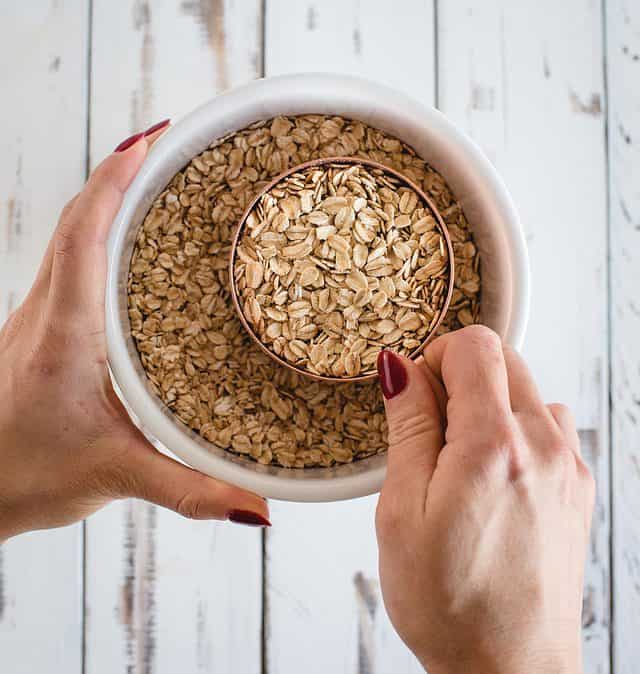
How much will it make
The amount of oat flour you end up with will vary based on the type of oats used. For 1 cup of rolled oats, you can expect to get slightly more than 1 cup of flour after blending.
Grinding whole oats into flour seems to defy the laws of physics and can be baffling. Since most of you have better things to do than weigh oats, I’ll break it down for you. Grinding makes oats less dense so you’ll typically get a higher volume of flour than you had in oats.
Ratio for grinding different types of oats
Different oats yield different amounts of flour. Here is a guide for how much flour to expect from 1 cup of oats after blending into your own oat flour:
- Steel-cut oats will yield just over 1 1/3 of oat flour
- Rolled oats (aka old-fashioned oats) creates a little over a cup of flour, about 1 cup + 1 Tbsp.
- Thick cut rolled oats will create about 1 cup + 2 Tablespoons of oat flour
- Quick oats will create slightly less than a cup
In measuring oat flour, aim for each up to weight 95-100 grams for consistency
All measurements were spooned and leveled but I tried weighing simply using the scoop and level method and got pretty much the same weight. A good practice is to stir oat flour (or any flour) before measuring to fluff it up if using the scoop and level method.
The density of the oats affects the end volume, although it does not affect the weight. You’ll find that steel cut oats are much more dense than rolled or quick-cooking oats are. Many guides for how to make oat flour from different kinds of oats get this wrong so be careful!
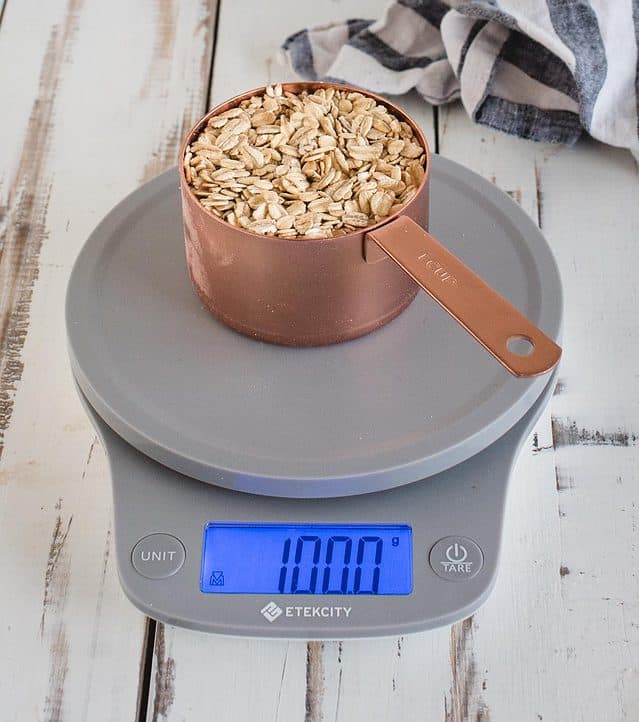
How to make oat flour
Oat flour is exceptionally easy to make. There are two simple steps:
- Put oats in a high-speed blender and blend until they become a fine powder consistency (1-2 minutes depending on your blender).
- Use a rubber spatula to scrape down the ground oats from the sides. Pulse for 30 seconds longer until the flour is an even consistency.
- Remove the flour from the blender and use it in recipes calling for oat flour or store it for future use in an air tight container away from direct light for 3-6 months.
The recipe is written for 2 cups of flour at a time but you can do up to 4 cups in a standard sized blender. Small batches tend to work best and provide the most consistency so do not overfill your blender.
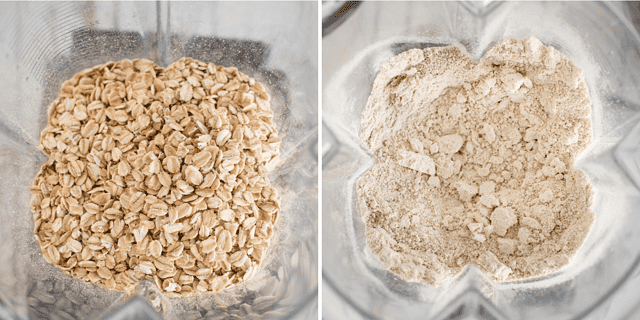
How to store and shelf life
To store and extend shelf life, place it into an airtight container, ideally glass, and store away from direct light. Pantry storage is ideal and if stored properly it will last for 3-6 months or even longer. The shelf life depends on the type of oat used, how fresh they were and how it is stored.
I have seen some guides say to keep it in the freezer but DO NOT do this. Moisture will inevitably creep in and affect the texture.
Check the expiration date on the oats you’re using before beginning and use fresh oats. Use a piece of masking tape and write the date you blended your oat flour on the bottom of your storage container. If there was a best by date on the oats you used, write that on there too. If it has gone bad, you may notice a change in texture, color or smell. Most often, when it becomes stale, it will start to develop a stale, sour smell and once it actually goes bad it will become darker in color.
Is oat flour gluten free
While oats are naturally gluten free, oat flour is not unless it says “gluten-free oat flour” on the packaging. Oats are often processed on machines that process wheat and are grown and transported with other grains containing gluten. This causes most oats to end up having small amounts of gluten in them.
If you have celiac disease, are cooking for someone with celiac disease, are gluten intolerant or just following a gluten-free diet be sure to seek out oat products that clearly state they are gluten free on the packaging. This means it is made with certified gluten free oats. Some people with celiac disease cannot process a form of protein found in the oats themselves either. If this is the case, you may need to substitute an alternative flour and avoid oats altogether.
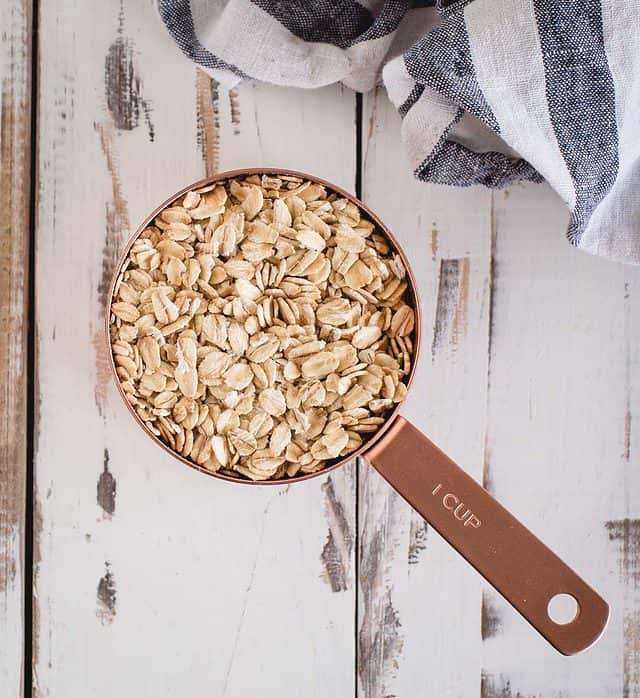
Frequently asked questions
No, it cannot. Oat flour is much more absorbent and your end product will not have the right texture. If you’re wondering how to substitute oat flour in recipes, I would advice you to proceed with caution. I have seen other bloggers recommend replacing at a ratio of 1 1/3 cups of oat flour to 1 cup of regular flour. I’ve seen others recommend replacing 1:1 by weight using a kitchen scale instead of by volume using measuring cups.
Do this at your own risk! I have tried and sometimes it works and in other recipes it does not. There are many factors (liquids used, number of eggs, etc.) that determine if it will work or not and since there are many oat flour recipes available, use one of them for best results.
This really depends on your food processor. When I tested this, my food processor did not break the oats down fine enough and the resulting consistency was not flour-like enough to get the best consistency in baking but a more powerful food processor could do the job and others report getting good results. Alternatively, a coffee grinder works but can be very messy since you need to work in small batches.
Yes! When using it for pancakes or waffles just let the batter sit for 5-10 minutes before scooping onto the oiled hot pan or into the waffle maker. I have a recipe for oat flour waffles that is excellent. It uses almond flour too to add some protein.
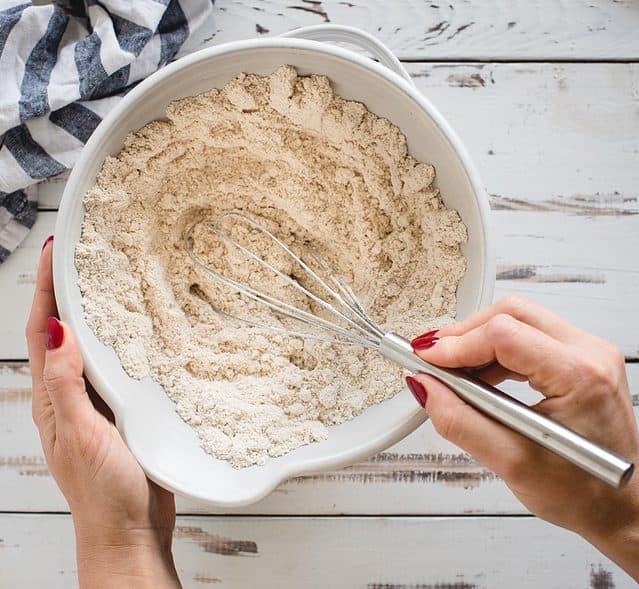
Recipes
There are so many good oat flour recipes out there! It works great in muffins, quick breads and breakfast foods in general. Here is a list of my favorite baking recipes:
- Peanut butter banana muffins
- Oat flour waffles
- Banana almond butter muffins
- Oat flour pancakes
- Carrot muffins
- Pumpkin muffins
Equipment
Ingredients
- 2 cups rolled oats weighs about 100 grams
Instructions
- Place rolled oats in blender and blend at high speed until oats become flour (1-2 minutes).
- Use a rubber spatula to scrape down the sides and pulse for 30 seconds longer until the flour is an even consistency.
- Remove oat flour from the blender and use it in recipes calling for oat flour or store it for future use in an air tight container away from direct light for 3-6 months.
Notes
- The amount of oat flour you end up with will vary based on the type of oats used. For 1 cup of rolled oats, you can expect to get slightly more than 1 cup of oat flour after blending.
- The amount of time oat flour will keep depends on the type of oat used and how fresh they are. You can use a piece of masking tape and a pen to write the date you blended your oat flour on the bottom of your storage container.
Nutrition
did you make this recipe?
Make sure to follow on Pinterest @feastingnotfasting and on Instagram @feastingnotfasting
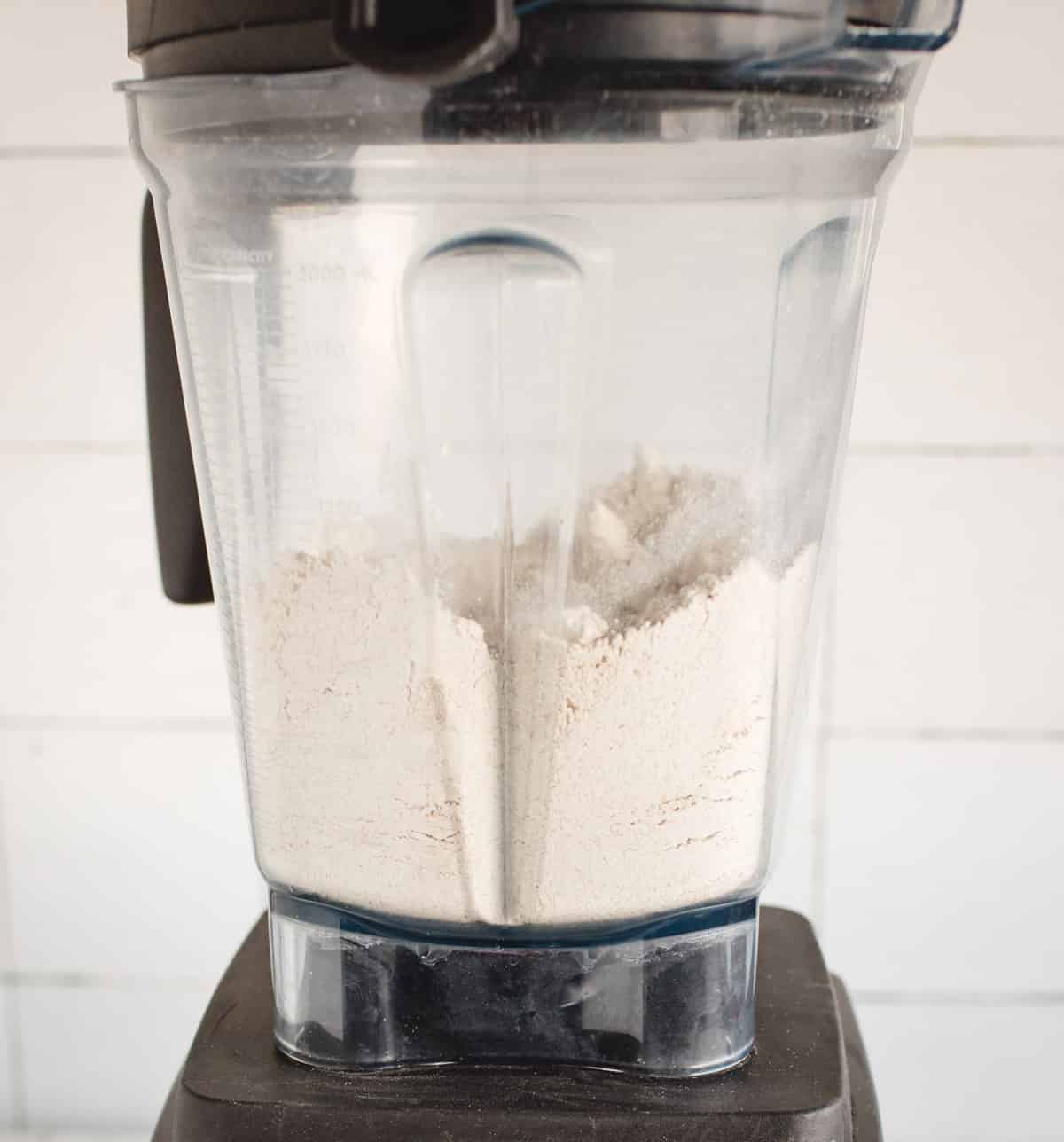
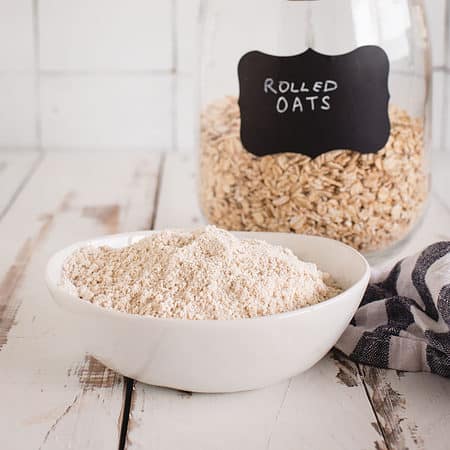








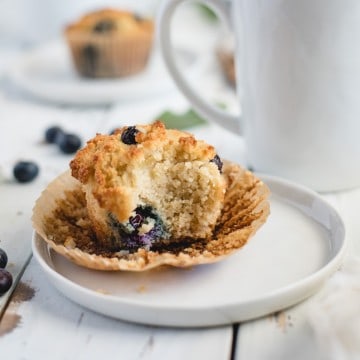

Comments & Reviews
Thanks for sharing.
I use my coffee grinder to make oat meal. Takes less than 30seconds for 100g and the result is just like you would buy oat flour. Perfect for making shakes if you are working out.
Just made a huge batch and am making your waffle recipe now!
So easy! Enjoy those waffles and let me know what you think of the recipe! Thank you so much for leaving a comment too. 🙂